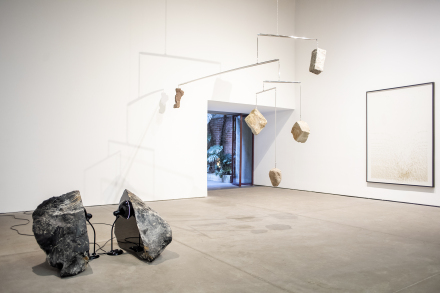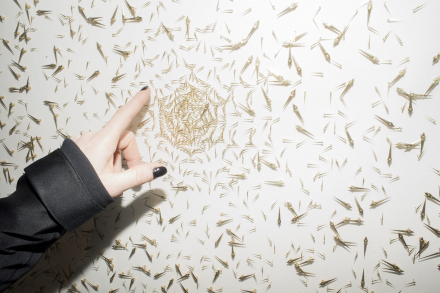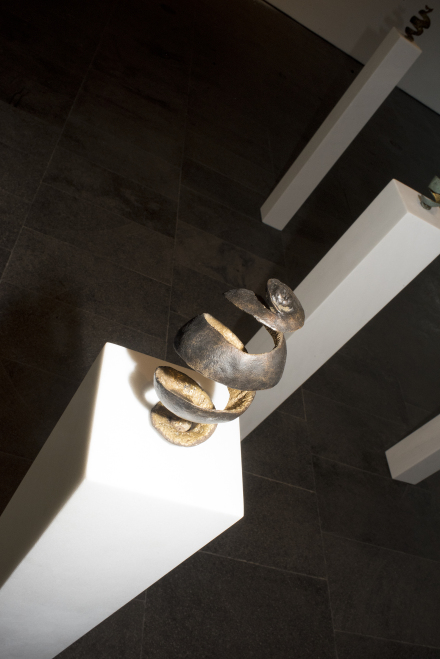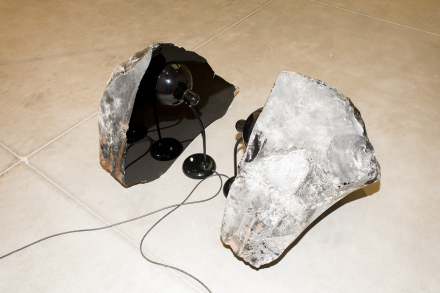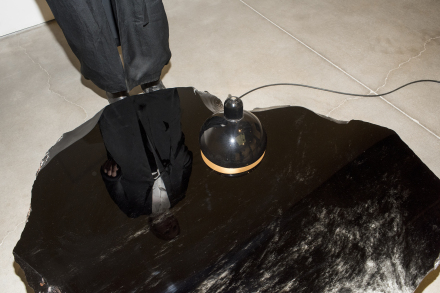
All Photography by Aleph Molinari for Art Observed
Through her multi-media sculptures and large-scale installations, Polish-German artist Alicja Kwade explores natural and social systems and the underlying structures of reality. Her precise and technically complex works are physical representations of order, scale, and systems that extend from the subatomic to the celestial. Integrating physics and mathematics into her formal language, Kwade creates ethereal – and almost improbable – spatial compositions.
Art Observed sat down with Kwade to talk about her formative experience growing up in Germany at the cusp of political upheaval, the philosophical approach to her work, and her latest exhibition Silent Matter at OMR in Mexico City. In the minimal, brutalist space of the gallery, Kwade created a delicate universe entirely of her own.
ANFISA VRUBEL (ART OBSERVED) – I wanted to start with your background to get a sense of where your ideas and inspirations come from. You were born in Poland at the height of the Cold War, and I read an interesting story of your family’s almost cinematic escape to West Germany…
ALICJA KWADE – Yes. We actually didn’t plan to end up in West Germany. My parents were forced to leave Poland because they didn’t share the ideals of the given system. My father ran an art gallery and was under constant political pressure. They would smash his windows because he wouldn’t show what the government wanted him to show. My mother was a professor at a university and got involved with the Solidarity Movement, which was not looked upon well. They couldn’t see a way for us to continue living in Poland, so we left in 1987. We were on our way to Canada, but as is often the case with refugee stories, someone appeared in Germany and so we stayed.
ANFISA VRUBEL – It must have been a jarring experience to go from one ideological and political reality to a radically different one.
ALICJA KWADE – I was only eight years old, so I remember it through a very different filter. I wasn’t completely aware of what was happening around me, but in retrospect, I understand the context. Back then, Germany was a completely different planet. I’m probably the last generation that lived through that because some years later, the Berlin Wall came down and the world changed completely. I’m grateful for the experience because not many people are able to experience that life is possible in a very different system.
ANFISA VRUBEL – The Cold War and the Iron Curtain seemed like unshakeable political realities at that time, but of course they were transforming. The experience of being able to see an alternative, to know that the system is not a monolith, must have been transformative.
ALICJA KWADE – Absolutely. I truly don’t believe in any kind of system – whether it’s an emotional or ideological system – and definitely not in any political system. There are no right or wrong systems. There are just inventions and agreements. My parents were always against the government, and always told me to not believe in what others told me to believe in.
ANFISA VRUBEL – Ultimately, every system is a consensus of sorts. It’s interesting how that translates into your work, which deals with physical representations of order, scale, and systems. How does your visual language represent abstract systems – political, economic, social?
ALICJA KWADE – This is actually the core of my work. I try to understand systems to their deepest level, to unfold and visualize them to the very last detail. And this process always brings up new questions, because when you analyze stock market values or national borders or time, for example, you figure out that it’s not even that abstract in the end. It’s more like one agreement based on another agreement, based on needs, based on a social system, based on rudimentary and brutal impulses. I mean, why is the time system what it is? Because it was observed from the Northern Hemisphere, and for different political reasons it became the standard. Even scientific results aren’t always neutral, but are colored by different interests and interpreted and presented accordingly. Additionally, almost all questions and conclusions can be made visual, and this leads to the absurd human tendency of trying to represent things that are beyond our comprehension. I mean, we depict wormholes and even the Big Bang as funny trumpet-like shapes, which is simply absurd in my view.
ANFISA VRUBEL – I really like your point about how anything can be broken down to its infinitesimal parts. You deconstruct to understand. Many of the concepts and ideas that you work with are scientific, which you distill into a visual language. So is a function of your art to visualize theory and science?
ALICJA KWADE – I don’t really make a distinction between philosophical and scientific questions. I mean, it’s all the same story. Even if you begin by questioning simple things around you, you inevitably arrive at larger scientific questions. You ask yourself what the glass on the table is made of and it quickly leads you to the entire universe and quantum physics. I wouldn’t even describe it as scientific thinking. For me it’s more like logical thinking from one axiom to another, connected to philosophy more than to science.
ANFISA VRUBEL – So it’s a way of building constellations of questions and extending the inquiry further. Are there any specific philosophical theories that resonate with you?
ALICJA KWADE – I find the theories of both the realists and the skeptics compelling. One school says that the world exists as it is, and we’re a part of it. The other school says, no, the world does not exist, it’s all happening in our heads. I love both arguments, and I believe that there’s not much of a real world. Ultimately, we are stuck to a rotating rock. I think that much is pretty sure. The rest is about our senses and our interpretation of them.
ANFISA VRUBEL – Your works are structurally complex and require a mathematical approach, especially in their proportions and scale. What is the process of materializing ideas into your sculptures and installations?
ALICJA KWADE – Indeed, I use mathematics and proportions and systems to create a clear formal body. It allows me to make choices with more than just my feelings alone, and to use tools that help me be as clear and precise as I can be in my visual language. But I don’t have to follow a formula, that is the freedom of an artist. I am just mixing things up, which probably nobody would ever do in physics or math. I sketch an idea in my studio, then I pass it to my team of architects and engineers, and I step away so they can figure out how it would be possible. It’s a back and forth.
ANFISA VRUBEL – Your work is precise yet seemingly effortless in the way elegant things always are. I remember the installation you did for Paris+ Art Basel last fall, in Place Vendôme. I love how you used the urban context. How do you approach a site and enter into a dialogue with it?
ALICJA KWADE – It’s always different. I wish I could just choose the places where I want to show, but for practical reasons that’s not always the case. I do a lot of site-specific commissions for private and public places. I go to the site and I put all aspects together and try to find a compromise between my vision, the vision of the institution that’s inviting me, and the site. I don’t waste much time on things which I can’t make. Right now, I’m working under the Tai Kwun Museum in Hong Kong, where we’re doing a large site-specific installation. And I really liked creating the installation for the rooftop of the Metropolitan Museum in New York.
ANFISA VRUBEL – I loved that installation – the juxtaposition of your works against the emerald canopy of the park, and then the buildings beyond.
ALICJA KWADE – It was very much about that juxtaposition. That piece was made specifically for the rooftop, with the sky and the horizon and the skyscrapers. At some point, though, the work also has to function somewhere else. The installation ended up at a huge farm – actually it’s a sculpture garden with a forest behind it – where it got a completely new life, which I wouldn’t have expected. All of my works can have a different life in a different context that is not connected to me anymore. I believe that an art piece shouldn’t be too connected to its creator, but should be its own living creature, independent.
ANFISA VRUBEL – Yes, morphing and responding to different contexts without your intervention. What would you say was your most complex project?
ALICJA KWADE – It’s difficult to say because there’s always so many factors and practical aspects involved. So far, I think it was Place Vendôme, because we didn’t have much physical or financial help. We had many restrictions from the city and really not much help installing it. We didn’t have much time either, so we had nine trucks arriving at night and installing everything super fast. It was mainly the team from my studio who did it all, from the engineering to physically installing these giant structures at Place Vendôme. I’m very proud of them because it was mission impossible.
ANFISA VRUBEL – It’s almost like the installation of the piece becomes a performance in itself, navigating the bureaucracy and coming in secretly at night [laughs].
ALICJA KWADE – Totally.
ANFISA VRUBEL – I’d like to talk about your current exhibit Silent Matter at OMR in Mexico City, which opened recently. Can you tell me about the work that you assembled, and how the exhibition came together?
ALICJA KWADE – OMR Gallery wanted to organize a show with me for a while, but I wasn’t into the idea of shipping a container of my work from Berlin to Mexico. So I was like, okay, we can do the show but we have to produce in Mexico because I don’t see the point of hanging the same works that I’m exhibiting in Paris or London or New York. And so OMR put in a lot of effort to make it happen, but then the pandemic came. It took a long time, but we were finally able to produce half of the show in Mexico.
ANFISA VRUBEL – And what was the experience of working in Mexico like? Did you use local materials for the exhibition?
ALICJA KWADE – The gallery introduced me to interesting producers and sites, which led me to discover obsidian as a material for the new pieces. I always use rocks, mirrors, and lamps, so obsidian allowed me to meld those elements together and let the stone become a mirror. It was a challenge because these pieces are made of large chunks of obsidian, which is hard to work with because it’s basically volcanic glass and can break easily.
ANFISA VRUBEL – I really like the obsidian pieces. Obsidian was widely used in pre-Hispanic culture, so it’s an apt historical connection.
ALICJA KWADE – Yes, absolutely. Although I don’t feel educated enough about pre-Hispanic culture to be confident in saying that I’m referring to that. But I’m fascinated with the material, which was used to sculpt tools, weapons, and figurines of deities. I also heard that shamans would use obsidian as a black mirror to see into the future. It’s a material loaded with significance.
ANFISA VRUBEL – Totally. A black hole made of an earthly stone, tying past and future together. And can you talk about the large mobiles, which to me are reminiscent of galaxies or planetary systems.
ALICJA KWADE – Yes. I began making mobiles two years ago, and they require advanced engineering. The mobiles look light, as if floating gently in space, but in reality, they are made of super heavy stones. They have zero tolerance, which means that if you take away one gram, the whole structure would collapse. We had to scratch away tiny pieces of the rocks until they reached the exact amount of weight required. It’s really the most extreme experiment with balance. And together with the obsidian pieces, they represent the basic forces that create our world and that play a role in shaping our lives. The obsidian comes from powerful volcanoes that erupt to the surface, from the supercore of our planet which is the mother of everything – the stars, the planets, all of it. It’s pure energy. So I’m collecting all these forces that are constantly influencing us.
– A. Vrubel
Read more:
Silent Matter at OMR [Exhibition Site]

